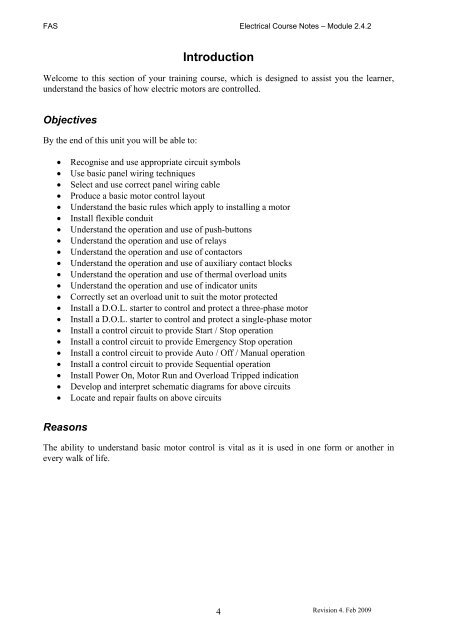Trade of Electrician Motor Control COURSE NOTES - eCollege
Trade of Electrician Motor Control COURSE NOTES - eCollege
Trade of Electrician Motor Control COURSE NOTES - eCollege
You also want an ePaper? Increase the reach of your titles
YUMPU automatically turns print PDFs into web optimized ePapers that Google loves.
FAS Electrical Course Notes – Module 2.4.2<br />
Introduction<br />
Welcome to this section <strong>of</strong> your training course, which is designed to assist you the learner,<br />
understand the basics <strong>of</strong> how electric motors are controlled.<br />
Objectives<br />
By the end <strong>of</strong> this unit you will be able to:<br />
Recognise and use appropriate circuit symbols<br />
Use basic panel wiring techniques<br />
Select and use correct panel wiring cable<br />
Produce a basic motor control layout<br />
Understand the basic rules which apply to installing a motor<br />
Install flexible conduit<br />
Understand the operation and use <strong>of</strong> push-buttons<br />
Understand the operation and use <strong>of</strong> relays<br />
Understand the operation and use <strong>of</strong> contactors<br />
Understand the operation and use <strong>of</strong> auxiliary contact blocks<br />
Understand the operation and use <strong>of</strong> thermal overload units<br />
Understand the operation and use <strong>of</strong> indicator units<br />
Correctly set an overload unit to suit the motor protected<br />
Install a D.O.L. starter to control and protect a three-phase motor<br />
Install a D.O.L. starter to control and protect a single-phase motor<br />
Install a control circuit to provide Start / Stop operation<br />
Install a control circuit to provide Emergency Stop operation<br />
Install a control circuit to provide Auto / Off / Manual operation<br />
Install a control circuit to provide Sequential operation<br />
Install Power On, <strong>Motor</strong> Run and Overload Tripped indication<br />
Develop and interpret schematic diagrams for above circuits<br />
Locate and repair faults on above circuits<br />
Reasons<br />
The ability to understand basic motor control is vital as it is used in one form or another in<br />
every walk <strong>of</strong> life.<br />
4<br />
Revision 4. Feb 2009

















